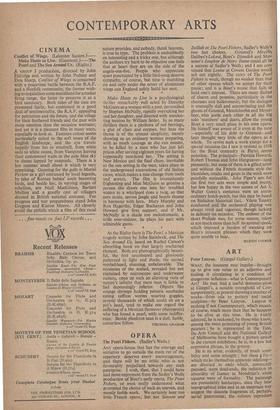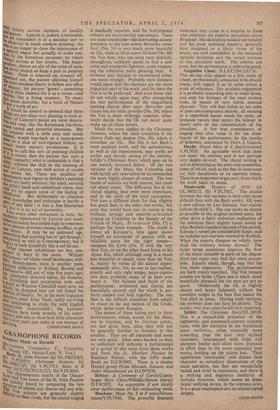ART
With., fidelity certain elements of locality tik season. Lanyon is, indeed, a naturalist, btelt his naturalism is of a peculiar sort to itizaobserved in much modern painting: the is no longer to show the appearance of 4 natural object but actually to make one, PI by the fortuitous processes by which Nature arrives at her results. The happy teltaident, always an ally of the artist of taste,
never played so large a part in painting be
tnrOre. Paint is smeared on, scraped off, Zueezed out, the painter allowing himself '171'110st absolute liberty to follow any effect ,1! chance; his picture 'grows'—something evolves t is often claimed for it as a virtue—and v thpsives like a living creature. To many ti seems desirable; but a work of Nature not a Work of art. tbilt Would be absurd to pretend that these E4!14s are not often very pleasing to look at. ft:1,1Y of Lanyon's pieces are most decora- r,' and may, like the Rorschach ink-blots, rise varied and powerful emotions. But ;14 selected with a little care and nicely 11_1111ed, would tree-bark or a moss-grown te or a slice of well-ripened Stilton; so Quid many nursery productions. It is 7?a8 to call this sort of painting childish 011 is meant that the painter has only a et,ad's eaPacity; what is undeniable is that a r,d, without the skill or the training of a en as Lanyon, may well arrive at results °t unlike his. There are qualities of svirchtaneity and vigour in children's painting are justly admired; the adult, envying wethollebild's lucid and unhabitual vision, may et: try to regain deliberately some of the feeling of adhood. But to abandon adult knowledge and technique is hardly a *IT Of any kind ; it has a fine libertarian ,.but it is an act of perversity. te ',Ike every other movement in taste, the ott`teneY represented by Lanyon and many to ers Proceeds by a simple logic to extremes; ue abreast of events means, in effect, to go one better. It may be an awkward age, t;tYlettling that painting has to 'et through,' oinorarY as well as Contempograry; but it girls to look dreadfully like a cul-de-sac. ee,er current exhibitions are less con-
:med to keep in the swim. William
U1 Olson--of whose small landscapes, still- es, flower-pieces, there is another post- us collection collection at Roland, Browse and 1,,etbanco's—fell out of time five years ago; his admirably directed talent, his .humour, riendship and association with such Du .1 ou,P1 as Winston Churchill must now, no dos,',t,, be dropped into our old friend the quarters of history. So, in the most impatient ,--mrfets and coils .must John Nash, rashly surviving inuing to study the mild English collieries unperturbed ; the Leicester coal leries have some seventy of his water- Ours and oils to show how little alteration �irtY-fiv years can make in one manner of painting.
CHRISTOPHER SMALL



















































 Previous page
Previous page